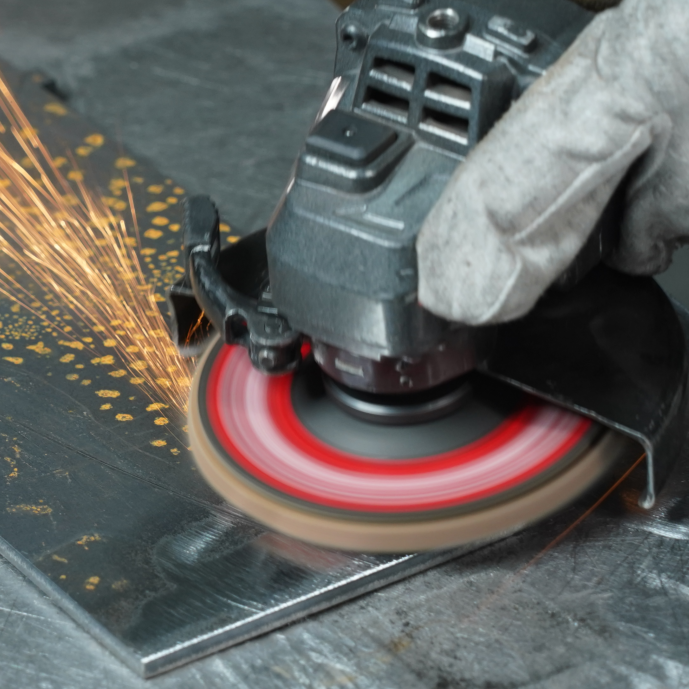Flap discs are a go-to tool for many industries, especially when it comes to grinding, blending, and finishing surfaces. But have you ever wondered how two flap discs with the same mesh size can behave so differently simply because they use different abrasives? In this guide, we’ll dive deep into the topic to understand how abrasive types impact flap disc performance.
Table of Contents
1. What Are Flap Discs?
2. Understanding Mesh Size
1. What Does Mesh Size Indicate?
2. How Does Mesh Size Affect Performance?
3. Different Types of Abrasives
1. Overview of Abrasive Materials
2. Common Abrasive Types in Flap Discs
4. How Abrasive Materials Impact Flap Disc Performance
1. Durability and Lifespan
2. Material-Specific Applications
5. Aluminum Oxide vs. Zirconia Alumina
1. Key Features of Aluminum Oxide
2. Why Choose Zirconia Alumina?
6. Ceramic Abrasives: The Game-Changer
1. Superior Cutting Ability
2. High Heat Resistance
7. Silicon Carbide: Sharp but Brittle
1. Best Use Cases for Silicon Carbide
2. Limitations of Silicon Carbide
8. Comparative Analysis of Abrasives
1. Performance on Metal
2. Effectiveness on Non-Metal Surfaces
9. Choosing the Right Flap Disc for Your Job
1. Assessing the Material You’re Working On
2. Considering Longevity vs. Cost
10. Pro Tips for Using Flap Discs Effectively
11. Common Mistakes to Avoid
12. Conclusion and FAQs
What Are Flap Discs?
Flap discs are versatile grinding tools made by layering abrasive flaps onto a central backing plate. These flaps wear down during use, constantly exposing fresh abrasive material, which makes them incredibly efficient for continuous grinding and finishing tasks.
Understanding Mesh Size
What Does Mesh Size Indicate?
Mesh size refers to the grit or coarseness of the abrasive. It’s a measure of how many abrasive particles fit in a square inch of the screen. Higher mesh sizes indicate finer grits, while lower mesh sizes mean coarser abrasives.
How Does Mesh Size Affect Performance?
Mesh size determines the type of finish you’ll achieve. Coarser grits (low mesh) remove material quickly, while finer grits (high mesh) deliver smooth finishes.
Different Types of Abrasives
Overview of Abrasive Materials
Abrasives come in various materials, each with unique properties like hardness, durability, and heat resistance. These properties directly impact how the flap disc performs.
Common Abrasive Types in Flap Discs
1. Aluminum Oxide: Affordable and widely used.
2. Zirconia Alumina: Durable and self-sharpening.
3. Ceramic: High-performance abrasive.
4. Silicon Carbide: Ultra-sharp but less durable.
How Abrasive Materials Impact Flap Disc Performance
Durability and Lifespan
Durable abrasives like zirconia alumina and ceramic last longer than aluminum oxide, saving costs over time despite their higher price tag.
Material-Specific Applications
Different abrasives excel on different materials. For example, aluminum oxide is excellent for wood, while ceramic is better for hardened steel.
Aluminum Oxide vs. Zirconia Alumina
Key Features of Aluminum Oxide
Aluminum oxide is a great all-rounder. It’s affordable and suitable for softer metals and wood. However, it wears out faster than premium abrasives.
Why Choose Zirconia Alumina?
Zirconia alumina is a workhorse. Its self-sharpening property allows it to maintain cutting efficiency, making it ideal for tough jobs on metals.
Ceramic Abrasives: The Game-Changer
Superior Cutting Ability
Ceramic abrasives offer unmatched cutting power. They are designed for demanding applications like grinding hardened steel or titanium.
High Heat Resistance
Ceramic grains dissipate heat effectively, reducing the risk of overheating your workpiece.
Silicon Carbide: Sharp but Brittle
Best Use Cases for Silicon Carbide
Silicon carbide is excellent for non-metallic surfaces like glass, stone, and ceramics due to its sharpness.
Limitations of Silicon Carbide
Although sharp, silicon carbide is brittle and wears down quickly, making it unsuitable for heavy-duty metalwork.
Comparative Analysis of Abrasives
Performance on Metal
· Aluminum Oxide: Adequate but not long-lasting.
· Zirconia Alumina: Durable and efficient.
· Ceramic: Exceptional for hard metals.
Effectiveness on Non-Metal Surfaces
· Silicon Carbide: Best choice for delicate surfaces.
· Aluminum Oxide: Sufficient for wood and plastics.
Choosing the Right Flap Disc for Your Job
Assessing the Material You’re Working On
Match the abrasive type to your material. For example, use ceramic for stainless steel and silicon carbide for glass.
Considering Longevity vs. Cost
While premium abrasives like ceramic cost more, their extended lifespan and efficiency often make them the more economical choice.
Pro Tips for Using Flap Discs Effectively
· Use the correct angle (15–30 degrees) to maximize abrasive contact.
· Avoid excessive pressure to prevent overheating.
· Rotate the disc frequently to ensure even wear.
Common Mistakes to Avoid
1. Using the wrong abrasive for the material.
2. Applying too much pressure.
3. Neglecting regular inspections for wear and tear.
Conclusion
Choosing the right flap disc isn’t just about mesh size—it’s about understanding the abrasives. Aluminum oxide, zirconia alumina, ceramic, and silicon carbide all have unique strengths. Matching the abrasive to your material ensures optimal performance, efficiency, and cost-effectiveness.
FAQs
1. Can I use the same flap disc for all materials?
No, different materials require different abrasives for optimal results.
2. Which abrasive is best for stainless steel?
Ceramic abrasives are the best for stainless steel due to their cutting power and heat resistance.
3. Are zirconia flap discs worth the cost?
Yes, their durability and efficiency make them cost-effective for heavy-duty tasks.
4. Can I use a flap disc on wood?
Yes, but aluminum oxide is the most suitable for woodworking.
5. How do I prolong the life of a flap disc?
Use proper technique, avoid excessive pressure, and store discs in a dry, cool environment.

 Oscillating Multi-Tool Blades
Oscillating Multi-Tool Blades
 Reciprocating Saw Blades
Reciprocating Saw Blades
 Cutting & Grinding
Cutting & Grinding
 Hole Saw
Hole Saw
 Drilling
Drilling
 Sanding & Polishing
Sanding & Polishing
 Hand Tools
Hand Tools
 BEST SELLERS
BEST SELLERS
 NEW ARRIVALS
NEW ARRIVALS
 Clearance Sale
Clearance Sale


Laisser un commentaire
Ce site est protégé par hCaptcha, et la Politique de confidentialité et les Conditions de service de hCaptcha s’appliquent.